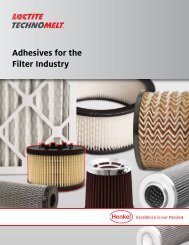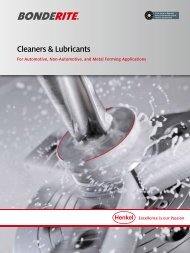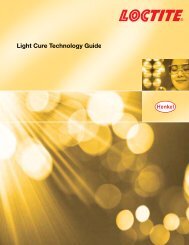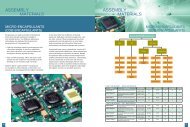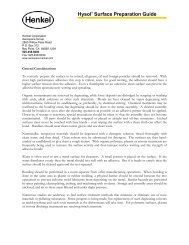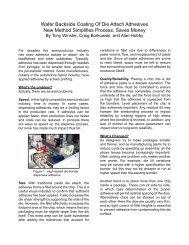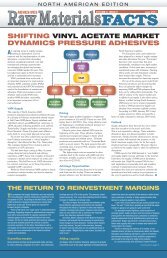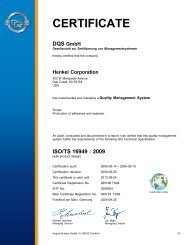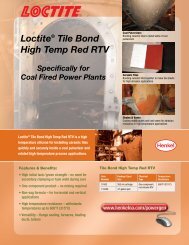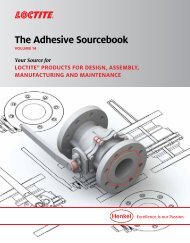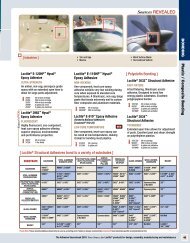Assembly of Plastic Adhesive Components
Assembly of Plastic Adhesive Components
Assembly of Plastic Adhesive Components
Create successful ePaper yourself
Turn your PDF publications into a flip-book with our unique Google optimized e-Paper software.
Finally, plastics can be tailored with great precision to meet the specific needs <strong>of</strong> appliance<br />
manufacturers. Virtually limitless combinations <strong>of</strong> plastic types, fillers, and additives are<br />
available which can be compounded at relatively low costs and processed by a variety <strong>of</strong><br />
methods. By properly selecting plastic types/blends, additives and fillers, the physical, chemical<br />
and thermal properties <strong>of</strong> the plastic can be made to meet or exceed the performance<br />
requirements <strong>of</strong> almost any application.<br />
Assembling Appliances With <strong>Plastic</strong> Parts<br />
For appliance manufacturers that require a method <strong>of</strong> assembly that is suitable for automation<br />
and results in a durable, aesthetically pleasing end-product, fastening with adhesives <strong>of</strong>fers the<br />
most versatility.<br />
Whether bonding plastic to plastic or plastic to another material, adhesives <strong>of</strong>fer several major<br />
benefits. Whereas mechanical fastening methods concentrate the stress in one spot, with<br />
adhesives, the load is spread over a wide area, reducing the amount <strong>of</strong> stress on the joint. As<br />
adhesives are applied inside the joint itself, they become an invisible component in the<br />
assembly. Mechanical fasteners such as rivets, nuts, and bolts require holes to be drilled into<br />
the assembly, and frequently interfere with the aesthetic styling <strong>of</strong> the product. Neither<br />
ultrasonic nor solvent welding can bond plastic to metals or glass — only adhesives can provide<br />
such a bond. Also, adhesives are a lower cost fastening method — mechanical fasteners must<br />
be inventoried, require pre-assembly preparation, and are labor intensive. <strong>Adhesive</strong>s are onesize-fits-all,<br />
and assembly can be easily automated.<br />
While the limitless variety <strong>of</strong> plastics is an invaluable asset to an appliance designer, it is also<br />
the biggest limitation when selecting an adhesive to bond a plastic assembly together. The<br />
countless adhesives available, coupled with the virtually limitless grades <strong>of</strong> plastic, make it<br />
difficult to determine the bond strength data for the adhesive/plastic combination designed into a<br />
specific appliance. However, by analyzing the fillers and additives that have been formulated<br />
into the plastic, the adhesive manufacturer can help to pinpoint the adhesive with the best bond<br />
strength for a specific application. To keep abreast <strong>of</strong> the latest developments in plastic<br />
materials, certain adhesive formulators have formed alliances with major plastics manufacturers<br />
to ensure the compatibility <strong>of</strong> their adhesive products, as well as the continued development <strong>of</strong><br />
new adhesives for the future.<br />
An adhesive cannot be selected for an application solely on the basis <strong>of</strong> bond strength. Other<br />
important factors play a critical role in determining the best adhesive for an application. These<br />
factors include cure speed, environmental and thermal resistance, and manual versus<br />
automated application methods.<br />
The newest and fastest growing adhesive technology for plastic bonding applications are new<br />
categories <strong>of</strong> ultraviolet (UV) and visible light curing adhesives. Light curing adhesives were first<br />
introduced approximately 30 years ago and are ideally suited for in-line, automated dispensing<br />
and curing. These adhesives cure or harden when exposed to light sources <strong>of</strong> the appropriate<br />
wavelength and intensity. The primary advantage <strong>of</strong> light cure processing is cure speed.<br />
Depending upon the product and system, cures can be achieved within seconds. Light cure<br />
adhesives are one-part systems with no need to measure or mix, and no pot life concerns.<br />
They contain no solvents and, therefore, are environmentally friendly. Light cure adhesives<br />
<strong>of</strong>fer a very rapid (2 to 60 second) room temperature cure and require substantially less<br />
equipment space and energy than ovens. These adhesives cure “on command,” allowing the<br />
manufacturer as much time as necessary to align parts. Once cured, bonded parts may be



